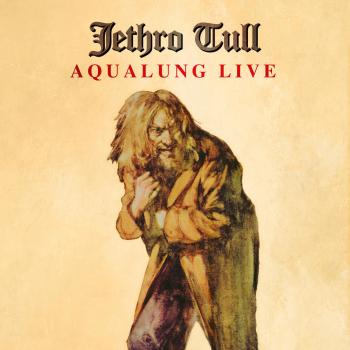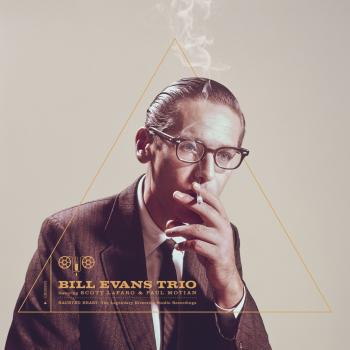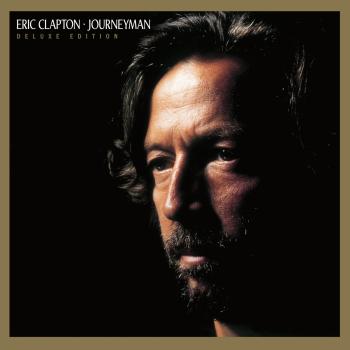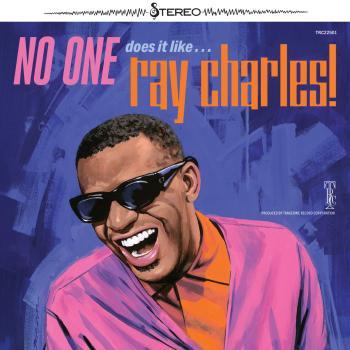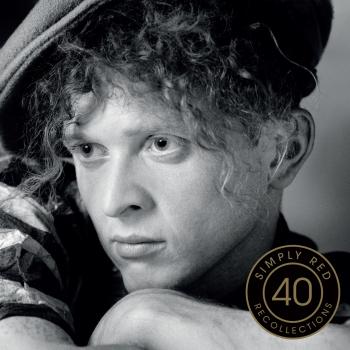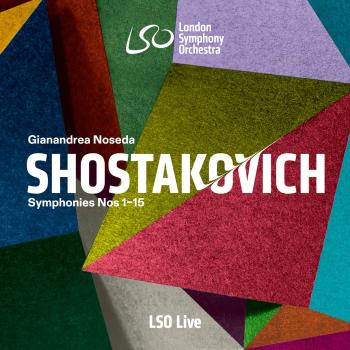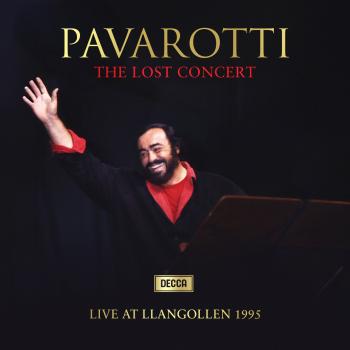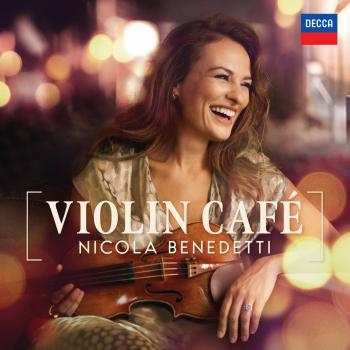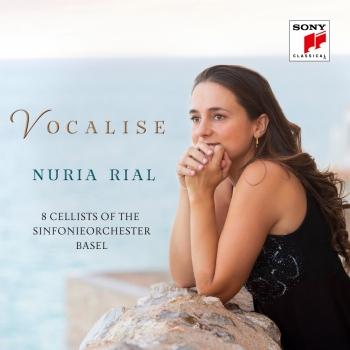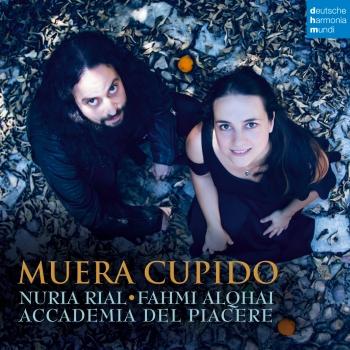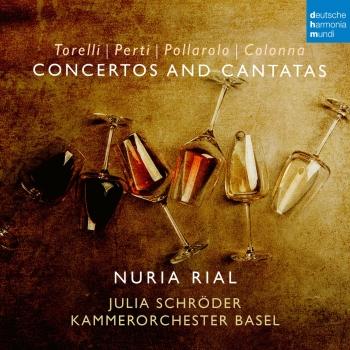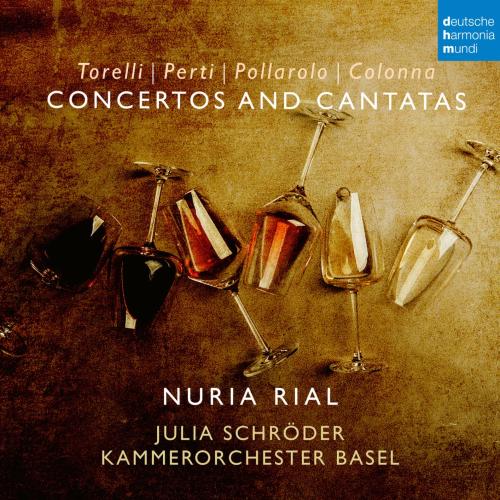
Colonna, Perti, Pollarolo, Torelli: Cantatas & Concertos Nuria Rial
Album info
Album-Release:
2023
HRA-Release:
22.09.2023
Label: deutsche harmonia mundi
Genre: Classical
Subgenre: Vocal
Artist: Nuria Rial
Composer: Giuseppe Torelli (1658-1709), Giovanni Paolo Colonna (1637-1695), Giacomo Antonio Perti (1661-1756), Carlo Francesco Pollarolo (1653-1723)
Album including Album cover Booklet (PDF)
I`m sorry!
Dear HIGHRESAUDIO Visitor,
due to territorial constraints and also different releases dates in each country you currently can`t purchase this album. We are updating our release dates twice a week. So, please feel free to check from time-to-time, if the album is available for your country.
We suggest, that you bookmark the album and use our Short List function.
Thank you for your understanding and patience.
Yours sincerely, HIGHRESAUDIO
- Giovanni Paolo Colonna (1637 - 1695): Salomone amante (Ed. F. Lora):
- 1 Colonna: Salomone amante (Ed. F. Lora): Pensieri vaganti 07:43
- Giuseppe Torelli (1658 - 1709): Concerto grosso in D Major, op. 8, No. 12 (Ed. G. Sechi):
- 2 Torelli: Concerto grosso in D Major, op. 8, No. 12 (Ed. G. Sechi): I. Allegro 02:23
- 3 Torelli: Concerto grosso in D Major, op. 8, No. 12 (Ed. G. Sechi): II. Adagio e con affetto 01:29
- 4 Torelli: Concerto grosso in D Major, op. 8, No. 12 (Ed. G. Sechi): III. Allegro 01:23
- 5 Torelli: Concerto grosso in D Major, op. 8, No. 12 (Ed. G. Sechi): IV. Adagio 03:10
- Giacomo Antonio Perti (1661 - 1756): Cantata per San Tomaso d'Aquino (Ed. G. Sechi):
- 6 Perti: Cantata per San Tomaso d'Aquino (Ed. G. Sechi): I. Vieni pur con i tuoi vezzi (Aria) 03:13
- 7 Perti: Cantata per San Tomaso d'Aquino (Ed. G. Sechi): II. Ecco dall'alto polo (Recitativo) 00:30
- 8 Perti: Cantata per San Tomaso d'Aquino (Ed. G. Sechi): III. Ogni spirto in ciel beato (Aria) 03:06
- Giuseppe Torelli: Concerto grosso in C Major, op. 8, No. 1 (Ed. G. Sechi):
- 9 Torelli: Concerto grosso in C Major, op. 8, No. 1 (Ed. G. Sechi): I. Vivace 02:29
- 10 Torelli: Concerto grosso in C Major, op. 8, No. 1 (Ed. G. Sechi): II. Largo 01:53
- 11 Torelli: Concerto grosso in C Major, op. 8, No. 1 (Ed. G. Sechi): III. Allegro ma non presto - Adagio 01:34
- 12 Torelli: Concerto grosso in C Major, op. 8, No. 1 (Ed. G. Sechi): IV. Allegro 02:15
- Concerto grosso in D Minor, op. 8, No. 7 (Ed. G. Sechi):
- 13 Torelli: Concerto grosso in D Minor, op. 8, No. 7 (Ed. G. Sechi): I. Allegro 02:00
- 14 Torelli: Concerto grosso in D Minor, op. 8, No. 7 (Ed. G. Sechi): II. Adagio e con affetto 01:07
- 15 Torelli: Concerto grosso in D Minor, op. 8, No. 7 (Ed. G. Sechi): III. Allegro - Adagio 01:19
- 16 Torelli: Concerto grosso in D Minor, op. 8, No. 7 (Ed. G. Sechi): IV. Allegro 02:43
- Carlo Francesco Pollarolo (1653 - 1723): Aurae sacrae amati ardores (Ed. G. Sechi):
- 17 Pollarolo: Aurae sacrae amati ardores (Ed. G. Sechi): I. Aurae sacrae amati ardores (Aria) 04:52
- 18 Pollarolo: Aurae sacrae amati ardores (Ed. G. Sechi): II. O clemens domine Deus (Recitativo) 00:39
- 19 Pollarolo: Aurae sacrae amati ardores (Ed. G. Sechi): III. Dulcis amor trine Deus (Aria) 04:47
- 20 Pollarolo: Aurae sacrae amati ardores (Ed. G. Sechi): IV. Alleluia (Aria) 01:55
- Giuseppe Torelli: Concerto grosso in E Major, op. 8, No. 3 (Ed. G. Sechi):
- 21 Torelli: Concerto grosso in E Major, op. 8, No. 3 (Ed. G. Sechi): I. Vivace 01:57
- 22 Torelli: Concerto grosso in E Major, op. 8, No. 3 (Ed. G. Sechi): II. Largo 01:12
- 23 Torelli: Concerto grosso in E Major, op. 8, No. 3 (Ed. G. Sechi): III. Allegro - Adagio 00:58
- 24 Torelli: Concerto grosso in E Major, op. 8, No. 3 (Ed. G. Sechi): IV. Allegro 02:52
Info for Colonna, Perti, Pollarolo, Torelli: Cantatas & Concertos
Mit dem 2017 erschienenen Album »Bologna 1666« nahm das Kammerorchester Basel unter der Leitung von Julia Schröder den Hörer mit auf eine musikalische Reise in das wohl wichtigste musikalische Zentrum Italiens im 17. Jahrhundert und entdeckte herausragende Werke. Die 1666 gegründete Accademia Filarmonica di Bologna, eine der ältesten Musikhochschulen Italiens, beeinflusste das damalige Musikleben weit über die Grenzen Italiens hinaus. Umso erstaunlicher ist es, dass mit Ausnahme einiger weniger Komponisten wie Giuseppe Torelli oder Giacomo Antonio Perti die meisten von ihnen in Vergessenheit geraten sind.
Bei dieser zweiten Aufnahme, die sich auf die bolognesische Schule konzentriert, fokussiert sich das Orchester mehr auf die Vokalmusik dieser Zeit. Sie werden von der fantastischen katalanischen Sopranistin Nuria Rial unterstützt. Die Vokalstücke sind alle inhaltlich miteinander verbunden, denn die Texte verwenden immer wieder »luftige« Bilder und Metaphern: ängstliche Gedanken eines gequälten Liebhabers, der keine Ruhe findet, als würde er vom Wind bewegt (die Arie »Pensieri vaganti« von Colonna), oder von Engeln, die vom Himmel herabsteigen, um die Menschen zu retten (in der Kantate »Vieni pur con i tuoi vezzi« von Perti), oder von der Aura, die man an heiligen Orten atmet (die Motette »Aurae sacrae amati ardores« von Pollarolo). Den Stücken für Sopran solo werden Auszüge aus den Concerti grossi op. 8 von Giuseppe Torelli gegenübergestellt, der in Venedig geboren wurde, aber seit 1684 in Bologna lebte und dort eine Karriere als Komponist machte.
Nuria Rial, Sopran
Kammerorchester Basel
Julia Schröder, Violine, Leitung
Nuria Rial
studierte Gesang und Klavier in ihrem Heimatland Katalonien. Sie wechselte nach Basel in die Klasse von Kurt Widmer, machte 2003 ihren Abschluss und gewann den Helvetia Patria Jeunesse in Luzern für ihre herausragenden Fähigkeiten als Sängerin.
Ihre feine, klare Stimme, das weich schwingende Timbre, Musikalität und Ausdrucksstärke, öffneten ihr auf internationaler Ebene rasch die Türen. Als Konzertsängerin arbeitet sie mit Dirigenten wie Sir John Eliot Gardiner, Paul Goodwin, Trevor Pinnock, Teodor Currentzis, Gustav Leonhardt, René Jacobs, Thomas Hengelbrock und Laurence Cummings. Dabei wird sie von Spitzenensembles wie Concerto Köln, The English Concert, Kammerorchester Basel, Collegium 1704, Il Giardino armonico, Les Musiciens du Louvre, Elbipolis Barockorchester, La Cetra Basel und L‘Arpeggiata begleitet.
Neben ihrer Konzerttätigkeit ist Nuria Rial auch immer wieder auf der Opernbühne zu erleben, wie in Monteverdis „Orfeo“ unter der Leitung von René Jacobs an der Staatsoper Unter den Linden in Berlin und in Cavallis „Eliogabalo“ in Brüssel. Wichtige Mozartpartien auf der Bühne waren Pamina in Genua und Ilia auf einer Tournee durch die Schweiz. Nuria Rial hat sich viel mit Barockmusik und historischer Aufführungspraxis beschäftigt und hat sich so einen Namen gemacht. Parallel dazu interessiert sie sich aber auch für andere Musikrichtungen. 2012 überzeugte sie zum Beispiel in der Rolle der Nuria in der zeitgenössischen Oper „Ainadamar“ von Golijov am Teatro Real Madrid, Regie Peter Sellars. 2015 wird sie mit dem Budapest Festival Orchestra unter der Leitung von Ivan Fischer erneut die Pamina singen.
Als begeisterte Kammermusikerin pflegt Nuria Rial Partnerschaften mit Ensembles wie „il pomo d‘oro“, „Café Zimmermann“ oder dem 'Nash Ensemble“. In ihren Liederabendprogrammen singt sie französisches und spanisches Repertoire, aber vermehrt auch das deutsche Lied.
Nuria Rial hat zahlreiche CDs für verschiedene Labels aufgenommen. Darunter die bekannte Figaro-Aufnahme mit René Jacobs. Seit Januar 2009 ist sie Exklusivkünstlerin bei Sony Classical/BMG Masterworks. Unter den letzten Aufnahmen waren ‚Traces to Anna Magdalena Bach‘ und Opernarien von Telemann, jeweils mit dem Kammerorchester Basel, 'Duetti amorosi' mit dem Countertenor Lawrence Zazzo und Händels 'Neun Deutsche Arien' mit der Austrian Baroque Company. Ihre CD „Ave Maria“ gewann den holländischen Edison Award.
Und preiswürdig ist sie bis heute geblieben. Im Jahr 2009 erhielt sie den beliebten Echo-Klassik-Preis gleich in zwei Kategorien. Zum einen war sie Nachwuchssängerin des Jahres mit dem Album „Haydn-Arie per un amante“ (L’Orfeo Barockorchester), und zum anderen wurde die CD „Teatro d’Amore“ mit Philipp Jaroussky (L'Arpeggiata) gekürt. 2010 folgte der Echo Klassik für die CD „Via Crucis“ mit Christina Pluhars „L’Arpeggiata“ und 2012 wurde Nuria Rial für ihre CD „Telemann“ mit dem Kammerorchester Basel in der Kategorie 'Beste Opernarien CD' ein weiterer Echo verliehen.
Artemandoline
With their ensemble Artemandoline, formed in 2001, Juan Carlos Muñoz and Mari Fe Pavón chose to go back to the original documents in order to the establish the true pedigree of this incomparable family of instruments. They have made a major contribution to launching a movement to encourage musical freshness and rigour. A better understanding of the compositions, closer study of the early treatises, the playing styles, the musical environment of the glorious era of the mandolin, leads to better appreciation of Baroque music, which itself became over time a mode of thought and action.
Searching for early mandolins, working on the manuscripts, hunting down early treatises, exploring the iconography: these are the means by which, for more than ten years now, the musicians of Artemandoline have sought to do fuller justice to the works of Scarlatti, Vivaldi, Weiss, and their contemporaries. The success of this approach based on a return to the sources, which constitutes the most important development in the history of the interpretation of ‘serious’ music in the course of the twentieth century, has been made possible by the cooperation of many protagonists – musicians, but also concert organisers, recording producers, publishers, musicologists, and instrument makers.
To ensure that music composed in the past does not sound like mere ‘early music’ in the present, the performers must manage to be sufficiently free, spontaneous, anticipative and astonished in their intimate act of creation and the newness it engenders. Juan Carlos Muñoz and Mari Fe Pavón spend their lives searching out and reviving forgotten masterpieces of the mandolin repertory. They are not content with simply presenting their finds like ‘musical archaeologists’, but endeavour to transmit them to the wider public by means of the essential act of communication between interpreters, composers, and listeners.
Very quickly awarded prizes by the critics and enthusiastically acclaimed by the public, Artemandoline’s performances always create new impulsions in the development of both the perception and the interpretation of the works of the seventeenth and eighteenth centuries. Its musicians dedicate their time and their talents to the revival of the mandolin on the musical scene, participating in the current expansion of interest in it all over the world through their conservatory teaching and masterclasses, their concerts, and their publications. Artemandoline is one of the pioneers in this domain, in which it has forged an international reputation.
In a few short years, the ensemble has found its style, proved its instrumental quality, and thereby constituted a veritable identity. Soon after its formation, it took its place among the foremost ensembles in the realm of historical performance practice on plucked strings. Audiences and critics alike were immediately filled with enthusiasm for its lively musical style.
The musicians who make up the ensemble play on period instruments: Baroque mandolins, Renaissance and Baroque guitar, Baroque mandola and mandolone, Renaissance lute, treble lutes, mandolins from Brescia and Cremona.
They are regularly invited to appear at early music festivals in France and abroad, including the Festival de Musique Ancienne du Marais, Festival du Périgord Vert, the « Tage Alter Musik Regensburg » in Germany ; « Early Music Day Alden-Biesen (Belgique) », Musique en Catalogne romane, Festival de l’Épine in France; Monza e Brianza, Gaudete Early Festival (Piedmont), and Castello Reale di Sarre (Aosta), all in Italy; Narol and Wroclaw in Poland; the Baroque Days at the Philharmonie in Luxembourg;; the Bach Chamber Days in Riga (Latvia); Festival Musique d’Ensemble à Pommiers, Oissery, Sedan, and other engagements in Spain, Japan, Switzerland, and Algeria.
The ensemble Artemandoline is in residence at the Romanesque church of Mont St Martin (Longwy, Meurthe-et-Moselle, France).
Booklet for Colonna, Perti, Pollarolo, Torelli: Cantatas & Concertos


